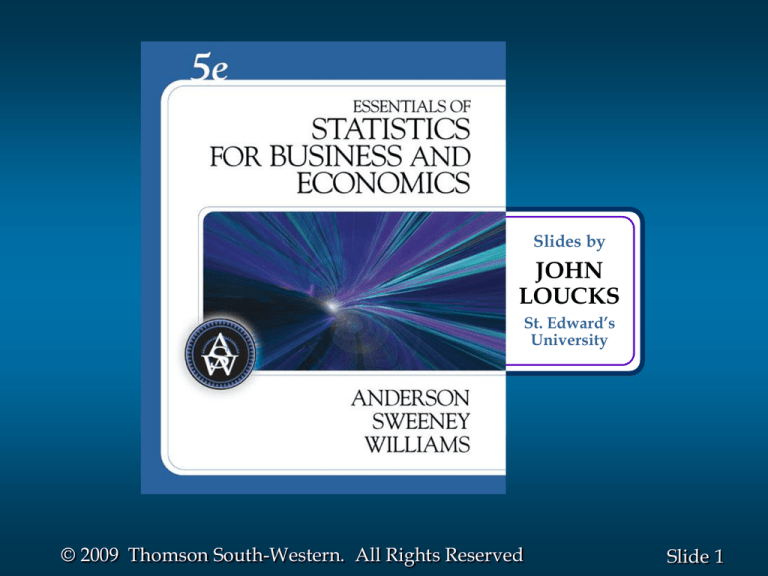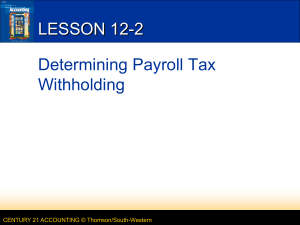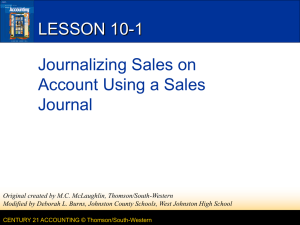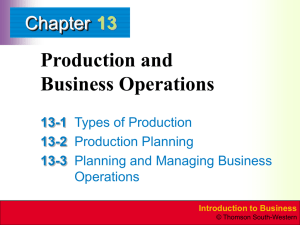
Slides by
JOHN
LOUCKS
St. Edward’s
University
© 2009 Thomson South-Western. All Rights Reserved
Slide 1
Chapter 9
Hypothesis Tests
Developing Null and Alternative Hypotheses
Type I and Type II Errors
Population Mean: s Known
Population Mean: s Unknown
Population Proportion
© 2009 Thomson South-Western. All Rights Reserved
Slide 2
Developing Null and Alternative Hypotheses
Hypothesis testing can be used to determine whether
a statement about the value of a population parameter
should or should not be rejected.
The null hypothesis, denoted by H0 , is a tentative
assumption about a population parameter.
The alternative hypothesis, denoted by Ha, is the
opposite of what is stated in the null hypothesis.
The alternative hypothesis is what the test is
attempting to establish.
© 2009 Thomson South-Western. All Rights Reserved
Slide 3
Developing Null and Alternative Hypotheses
Testing Research Hypotheses
• The research hypothesis should be expressed as
the alternative hypothesis.
•
The conclusion that the research hypothesis is true
comes from sample data that contradict the null
hypothesis.
© 2009 Thomson South-Western. All Rights Reserved
Slide 4
Developing Null and Alternative Hypotheses
Testing the Validity of a Claim
•
Manufacturers’ claims are usually given the benefit
of the doubt and stated as the null hypothesis.
• The conclusion that the claim is false comes from
sample data that contradict the null hypothesis.
© 2009 Thomson South-Western. All Rights Reserved
Slide 5
Developing Null and Alternative Hypotheses
Testing in Decision-Making Situations
•
A decision maker might have to choose between
two courses of action, one associated with the null
hypothesis and another associated with the
alternative hypothesis.
•
Example: Accepting a shipment of goods from a
supplier or returning the shipment of goods to the
supplier
© 2009 Thomson South-Western. All Rights Reserved
Slide 6
Summary of Forms for Null and Alternative
Hypotheses about a Population Mean
The equality part of the hypotheses always appears
in the null hypothesis.
In general, a hypothesis test about the value of a
population mean must take one of the following
three forms (where 0 is the hypothesized value of
the population mean).
H 0 : 0
H a : 0
H 0 : 0
H a : 0
H 0 : 0
H a : 0
One-tailed
(lower-tail)
One-tailed
(upper-tail)
Two-tailed
© 2009 Thomson South-Western. All Rights Reserved
Slide 7
Null and Alternative Hypotheses
Example: Metro EMS
A major west coast city provides one of the most
comprehensive emergency medical services in the
world.
Operating in a multiple hospital system with
approximately 20 mobile medical units, the service goal
is to respond to medical emergencies with a mean time
of 12 minutes or less.
© 2009 Thomson South-Western. All Rights Reserved
Slide 8
Null and Alternative Hypotheses
Example: Metro EMS
The director of medical services wants to formulate
a hypothesis test that could use a sample of emergency
response times to determine whether or not the service
goal of 12 minutes or less is being achieved.
© 2009 Thomson South-Western. All Rights Reserved
Slide 9
Null and Alternative Hypotheses
H0:
The emergency service is meeting
the response goal; no follow-up
action is necessary.
Ha:
The emergency service is not
meeting the response goal;
appropriate follow-up action is
necessary.
where: = mean response time for the population
of medical emergency requests
© 2009 Thomson South-Western. All Rights Reserved
Slide 10
Type I Error
Because hypothesis tests are based on sample data,
we must allow for the possibility of errors.
A Type I error is rejecting H0 when it is true.
The probability of making a Type I error when the
null hypothesis is true as an equality is called the
level of significance.
Applications of hypothesis testing that only control
the Type I error are often called significance tests.
© 2009 Thomson South-Western. All Rights Reserved
Slide 11
Type II Error
A Type II error is accepting H0 when it is false.
It is difficult to control for the probability of making
a Type II error.
Statisticians avoid the risk of making a Type II
error by using “do not reject H0” and not “accept H0”.
© 2009 Thomson South-Western. All Rights Reserved
Slide 12
Type I and Type II Errors
Population Condition
Conclusion
H0 True
( < 12)
H0 False
( > 12)
Accept H0
(Conclude < 12)
Correct
Decision
Type II Error
Type I Error
Correct
Decision
Reject H0
(Conclude > 12)
© 2009 Thomson South-Western. All Rights Reserved
Slide 13
p-Value Approach to
One-Tailed Hypothesis Testing
A p-value is a probability that provides a measure
of the evidence against the null hypothesis
provided by the sample.
The p-value is used to determine if the null
hypothesis should be rejected.
The smaller the p-value, the more evidence there
is against H0.
A small p-value indicates the value of the test
statistic is unusual given the assumption that H0
is true.
© 2009 Thomson South-Western. All Rights Reserved
Slide 14
Lower-Tailed Test About a Population Mean:
s Known
p-Value < a ,
so reject H0.
p-Value Approach
a = .10
Sampling
distribution
x 0
of z
s/ n
p-value
7
z
z = -za =
-1.46 -1.28
0
© 2009 Thomson South-Western. All Rights Reserved
Slide 15
Upper-Tailed Test About a Population Mean:
s Known
p-Value < a ,
so reject H0.
p-Value Approach
Sampling
distribution
x 0
of z
s/ n
a = .04
p-Value
z
0
za =
1.75
z=
2.29
© 2009 Thomson South-Western. All Rights Reserved
Slide 16
Critical Value Approach to
One-Tailed Hypothesis Testing
The test statistic z has a standard normal probability
distribution.
We can use the standard normal probability
distribution table to find the z-value with an area
of a in the lower (or upper) tail of the distribution.
The value of the test statistic that established the
boundary of the rejection region is called the
critical value for the test.
The rejection rule is:
• Lower tail: Reject H0 if z < -za
• Upper tail: Reject H0 if z > za
© 2009 Thomson South-Western. All Rights Reserved
Slide 17
Lower-Tailed Test About a Population Mean:
s Known
Critical Value Approach
Sampling
distribution
of z x 0
s/ n
Reject H0
a
Do Not Reject H0
z
za = 1.28
0
© 2009 Thomson South-Western. All Rights Reserved
Slide 18
Upper-Tailed Test About a Population Mean:
s Known
Critical Value Approach
Sampling
distribution
of z x 0
s/ n
Reject H0
Do Not Reject H0
a
z
0
za = 1.645
© 2009 Thomson South-Western. All Rights Reserved
Slide 19
Steps of Hypothesis Testing
Step 1. Develop the null and alternative hypotheses.
Step 2. Specify the level of significance a.
Step 3. Collect the sample data and compute the test
statistic.
p-Value Approach
Step 4. Use the value of the test statistic to compute the
p-value.
Step 5. Reject H0 if p-value < a.
© 2009 Thomson South-Western. All Rights Reserved
Slide 20
Steps of Hypothesis Testing
Critical Value Approach
Step 4. Use the level of significance to determine the
critical value and the rejection rule.
Step 5. Use the value of the test statistic and the rejection
rule to determine whether to reject H0.
© 2009 Thomson South-Western. All Rights Reserved
Slide 21
One-Tailed Tests About a Population Mean:
s Known
Example: Metro EMS
The response times for a random sample of 40 medical
emergencies were tabulated. The sample mean is 13.25
minutes. The population standard deviation is believed
to be 3.2 minutes.
The EMS director wants to perform a hypothesis test,
with a .05 level of significance, to determine whether the
service goal of 12 minutes or less is being achieved.
© 2009 Thomson South-Western. All Rights Reserved
Slide 22
One-Tailed Tests About a Population Mean:
s Known
p -Value and Critical Value Approaches
1. Develop the hypotheses.
H0:
Ha:
2. Specify the level of significance.
a = .05
3. Compute the value of the test statistic.
x 13.25 12
z
2.47
s / n 3.2 / 40
© 2009 Thomson South-Western. All Rights Reserved
Slide 23
One-Tailed Tests About a Population Mean:
s Known
p –Value Approach
4. Compute the p –value.
For z = 2.47, cumulative probability = .9932.
p–value = 1 .9932 = .0068
5. Determine whether to reject H0.
Because p–value = .0068 < a = .05, we reject H0.
There is sufficient statistical evidence
to infer that Metro EMS is not meeting
the response goal of 12 minutes.
© 2009 Thomson South-Western. All Rights Reserved
Slide 24
One-Tailed Tests About a Population Mean:
s Known
p –Value Approach
Sampling
distribution
of z x 0
s/ n
a = .05
p-value
z
0
za =
1.645
z=
2.47
© 2009 Thomson South-Western. All Rights Reserved
Slide 25
One-Tailed Tests About a Population Mean:
s Known
Critical Value Approach
4. Determine the critical value and rejection rule.
For a = .05, z.05 = 1.645
Reject H0 if z > 1.645
5. Determine whether to reject H0.
Because 2.47 > 1.645, we reject H0.
There is sufficient statistical evidence
to infer that Metro EMS is not meeting
the response goal of 12 minutes.
© 2009 Thomson South-Western. All Rights Reserved
Slide 26
p-Value Approach to
Two-Tailed Hypothesis Testing
Compute the p-value using the following three steps:
1. Compute the value of the test statistic z.
2. If z is in the upper tail (z > 0), find the area under
the standard normal curve to the right of z.
If z is in the lower tail (z < 0), find the area under
the standard normal curve to the left of z.
3. Double the tail area obtained in step 2 to obtain
the p –value.
The rejection rule:
Reject H0 if the p-value < a .
© 2009 Thomson South-Western. All Rights Reserved
Slide 27
Critical Value Approach to
Two-Tailed Hypothesis Testing
The critical values will occur in both the lower and
upper tails of the standard normal curve.
Use the standard normal probability distribution
table to find za/2 (the z-value with an area of a/2 in
the upper tail of the distribution).
The rejection rule is:
Reject H0 if z < -za/2 or z > za/2.
© 2009 Thomson South-Western. All Rights Reserved
Slide 28
Example: Glow Toothpaste
Two-Tailed Test About a Population Mean: s Known
The production line for Glow toothpaste is designed
to fill tubes with a mean weight of 6 oz. Periodically, a
sample of 30 tubes will be selected in order to check the
filling process.
Quality assurance procedures call for the continuation
of the filling process if the sample results are consistent
with the assumption that the mean filling weight for the
population of toothpaste tubes is 6 oz.; otherwise the
process will be adjusted.
© 2009 Thomson South-Western. All Rights Reserved
Slide 29
Example: Glow Toothpaste
Two-Tailed Test About a Population Mean: s Known
Assume that a sample of 30 toothpaste tubes provides
a sample mean of 6.1 oz. The population standard
deviation is believed to be 0.2 oz.
Perform a hypothesis test, at the .03 level of
significance, to help determine whether the filling process
should continue operating or be stopped and corrected.
© 2009 Thomson South-Western. All Rights Reserved
Slide 30
Two-Tailed Tests About a Population Mean:
s Known
p –Value and Critical Value Approaches
1. Determine the hypotheses.
H0:
Ha: 6
2. Specify the level of significance.
a = .03
3. Compute the value of the test statistic.
x 0
6.1 6
z
2.74
s / n .2 / 30
© 2009 Thomson South-Western. All Rights Reserved
Slide 31
Two-Tailed Tests About a Population Mean:
s Known
p –Value Approach
4. Compute the p –value.
For z = 2.74, cumulative probability = .9969
p–value = 2(1 .9969) = .0062
5. Determine whether to reject H0.
Because p–value = .0062 < a = .03, we reject H0.
There is sufficient statistical evidence to
infer that the alternative hypothesis is true
(i.e. the mean filling weight is not 6 ounces).
© 2009 Thomson South-Western. All Rights Reserved
Slide 32
Two-Tailed Tests About a Population Mean:
s Known
p-Value Approach
1/2
p -value
= .0031
1/2
p -value
= .0031
a/2 =
a/2 =
.015
.015
z
z = -2.74
-za/2 = -2.17
0
za/2 = 2.17
© 2009 Thomson South-Western. All Rights Reserved
z = 2.74
Slide 33
Two-Tailed Tests About a Population Mean:
s Known
Critical Value Approach
4. Determine the critical value and rejection rule.
For a/2 = .03/2 = .015, z.015 = 2.17
Reject H0 if z < -2.17 or z > 2.17
5. Determine whether to reject H0.
Because 2.74 > 2.17, we reject H0.
There is sufficient statistical evidence to
infer that the alternative hypothesis is true
(i.e. the mean filling weight is not 6 ounces).
© 2009 Thomson South-Western. All Rights Reserved
Slide 34
Two-Tailed Tests About a Population Mean:
s Known
Critical Value Approach
Sampling
distribution
x 0
of z
s/ n
Reject H0
Reject H0
Do Not Reject H0
a/2 = .015
-2.17
a/2 = .015
0
2.17
© 2009 Thomson South-Western. All Rights Reserved
z
Slide 35
Confidence Interval Approach to
Two-Tailed Tests About a Population Mean
Select a simple random sample from the population
and use the value of the sample mean x to develop
the confidence interval for the population mean .
(Confidence intervals are covered in Chapter 8.)
If the confidence interval contains the hypothesized
value 0, do not reject H0. Otherwise, reject H0.
© 2009 Thomson South-Western. All Rights Reserved
Slide 36
Confidence Interval Approach to
Two-Tailed Tests About a Population Mean
The 97% confidence interval for is
x za / 2
s
6.1 2.17(.2 30) 6.1 .07924
n
or 6.02076 to 6.17924
Because the hypothesized value for the
population mean, 0 = 6, is not in this interval,
the hypothesis-testing conclusion is that the
null hypothesis, H0: = 6, can be rejected.
© 2009 Thomson South-Western. All Rights Reserved
Slide 37
Tests About a Population Mean:
s Unknown
Test Statistic
x 0
t
s/ n
This test statistic has a t distribution
with n - 1 degrees of freedom.
© 2009 Thomson South-Western. All Rights Reserved
Slide 38
Tests About a Population Mean:
s Unknown
Rejection Rule: p -Value Approach
Reject H0 if p –value < a
Rejection Rule: Critical Value Approach
H0:
Reject H0 if t < -ta
H0:
Reject H0 if t > ta
H0:
Reject H0 if t < - ta or t > ta
© 2009 Thomson South-Western. All Rights Reserved
Slide 39
p -Values and the t Distribution
The format of the t distribution table provided in most
statistics textbooks does not have sufficient detail
to determine the exact p-value for a hypothesis test.
However, we can still use the t distribution table to
identify a range for the p-value.
An advantage of computer software packages is that
the computer output will provide the p-value for the
t distribution.
© 2009 Thomson South-Western. All Rights Reserved
Slide 40
Example: Highway Patrol
One-Tailed Test About a Population Mean: s Unknown
A State Highway Patrol periodically samples
vehicle speeds at various locations on a particular
roadway. The sample of vehicle speeds is used to
test the hypothesis
H0: < 65
The locations where H0 is rejected are deemed
the best locations for radar traps.
© 2009 Thomson South-Western. All Rights Reserved
Slide 41
Example: Highway Patrol
One-Tailed Test About a Population Mean: s Unknown
At Location F, a sample of 64 vehicles shows a
mean speed of 66.2 mph with a standard deviation of
4.2 mph. Use a = .05 to test the hypothesis.
© 2009 Thomson South-Western. All Rights Reserved
Slide 42
One-Tailed Test About a Population Mean:
s Unknown
p –Value and Critical Value Approaches
1. Determine the hypotheses.
H0: < 65
Ha: > 65
2. Specify the level of significance.
a = .05
3. Compute the value of the test statistic.
t
x 0 66.2 65
2.286
s / n 4.2 / 64
© 2009 Thomson South-Western. All Rights Reserved
Slide 43
One-Tailed Test About a Population Mean:
s Unknown
p –Value Approach
4. Compute the p –value.
For t = 2.286, the p–value must be less than .025
(for t = 1.998) and greater than .01 (for t = 2.387).
.01 < p–value < .025
5. Determine whether to reject H0.
Because p–value < a = .05, we reject H0.
We are at least 95% confident that the mean speed
of vehicles at Location F is greater than 65 mph.
© 2009 Thomson South-Western. All Rights Reserved
Slide 44
One-Tailed Test About a Population Mean:
s Unknown
Critical Value Approach
4. Determine the critical value and rejection rule.
For a = .05 and d.f. = 64 – 1 = 63, t.05 = 1.669
Reject H0 if t > 1.669
5. Determine whether to reject H0.
Because 2.286 > 1.669, we reject H0.
We are at least 95% confident that the mean speed
of vehicles at Location F is greater than 65 mph.
Location F is a good candidate for a radar trap.
© 2009 Thomson South-Western. All Rights Reserved
Slide 45
One-Tailed Test About a Population Mean:
s Unknown
Reject H0
Do Not Reject H0
0
a
ta =
1.669
© 2009 Thomson South-Western. All Rights Reserved
t
Slide 46
A Summary of Forms for Null and Alternative
Hypotheses About a Population Proportion
The equality part of the hypotheses always appears
in the null hypothesis.
In general, a hypothesis test about the value of a
population proportion p must take one of the
following three forms (where p0 is the hypothesized
value of the population proportion).
H 0 : p p0
H a : p p0
H 0 : p p0
H a : p p0
H 0 : p p0
H a : p p0
One-tailed
(lower tail)
One-tailed
(upper tail)
Two-tailed
© 2009 Thomson South-Western. All Rights Reserved
Slide 47
Tests About a Population Proportion
Test Statistic
z
p p0
sp
where:
sp
p0 (1 p0 )
n
assuming np > 5 and n(1 – p) > 5
© 2009 Thomson South-Western. All Rights Reserved
Slide 48
Tests About a Population Proportion
Rejection Rule: p –Value Approach
Reject H0 if p –value < a
Rejection Rule: Critical Value Approach
H0: p p
Reject H0 if z > za
H0: p p
Reject H0 if z < -za
H0: pp
Reject H0 if z < -za or z > za
© 2009 Thomson South-Western. All Rights Reserved
Slide 49
Two-Tailed Test About a
Population Proportion
Example: National Safety Council (NSC)
For a Christmas and New Year’s week, the
National Safety Council estimated that 500 people
would be killed and 25,000 injured on the nation’s
roads. The NSC claimed that 50% of the accidents
would be caused by drunk driving.
© 2009 Thomson South-Western. All Rights Reserved
Slide 50
Two-Tailed Test About a
Population Proportion
Example: National Safety Council (NSC)
A sample of 120 accidents showed that 67 were
caused by drunk driving. Use these data to test the
NSC’s claim with a = .05.
© 2009 Thomson South-Western. All Rights Reserved
Slide 51
Two-Tailed Test About a
Population Proportion
p –Value and Critical Value Approaches
1. Determine the hypotheses.
H 0 : p .5
H a : p .5
2. Specify the level of significance.
a = .05
3. Compute the value of the test statistic.
a common
error is using
p in this
formula
p0 (1 p0 )
.5(1 .5)
sp
.045644
n
120
z
p p0
sp
(67 /120) .5
1.28
.045644
© 2009 Thomson South-Western. All Rights Reserved
Slide 52
Two-Tailed Test About a
Population Proportion
pValue Approach
4. Compute the p -value.
For z = 1.28, cumulative probability = .8997
p–value = 2(1 .8997) = .2006
5. Determine whether to reject H0.
Because p–value = .2006 > a = .05, we cannot reject H0.
© 2009 Thomson South-Western. All Rights Reserved
Slide 53
Two-Tailed Test About a
Population Proportion
Critical Value Approach
4. Determine the criticals value and rejection rule.
For a/2 = .05/2 = .025, z.025 = 1.96
Reject H0 if z < -1.96 or z > 1.96
5. Determine whether to reject H0.
Because 1.278 > -1.96 and < 1.96, we cannot reject H0.
© 2009 Thomson South-Western. All Rights Reserved
Slide 54
End of Chapter 9
© 2009 Thomson South-Western. All Rights Reserved
Slide 55










